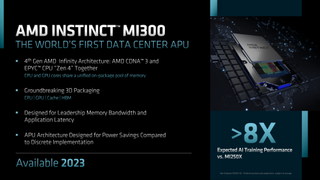AMD's latest APU could revolutionize supercomputers
Instinct MI300 is incoming...in 2023

AMD has confirmed that a next-gen CDNA 4 multi-chip and multi-IP Instinct accelerator is currently in development and scheduled to launch by 2023, known as the Instinct MI300 GPU. Technically speaking, this is actually an APU that will combine the next-generation of CDNA 3 cores with the next-generation Zen 4 CPU cores.
That's right - this chip combines CPU and GPU cores onto a single package for data centers and AI, and the anticipated performance boost is allegedly monstrous.
The Instinct MI300 accelerator has a unified memory APU architecture and new Math Formats to provide 5x performance-per-watt improvement over CDNA 2, as well as an 8x projected improvement in AI training performance versus its spiritual predecessor, the MI250X.
Instinct will make this possible using a 5nm process node and feature 4th Gen Infinity architecture. In essence, we should see improvements in performance as the unified architecture eliminates redundant memory copies and removes the need for a second memory pool of DRAM attached to the CPU.
These are AMDs own in-house stats of course, so take the performance predictions with a pinch of salt until real-world performance can be documented. An official release date has not been provided, though AMD confirmed during its Financial Analyst Day 2022 that it plans to launch Instinct MI300 in 2023.
David Wang announced the Instinct-class chips for the AI and Data Center segment alongside the Compute GPU roadmap, which also includes the likes of AMD RDNA 4 Gaming GPUs.
"These are where we think we can win in terms of differentiation," AMD CEO Lisa Su said in her opening remarks at the event. "It's about compute technology leadership. It's about expanding datacenter leadership. It's about expanding our AI footprint. It's expanding our software capability. And then it's really bringing together a broader custom solutions effort because we think this is a growth area going forward."
Are you a pro? Subscribe to our newsletter
Sign up to the TechRadar Pro newsletter to get all the top news, opinion, features and guidance your business needs to succeed!
Analysis: this won't be an easy win for AMD

This is far from AMD's first rodeo with supercomputing, having released its first data center GPU (the GCN-based Vega II) back in late 2018, followed up with its first CDNA-based Radeon Instinct MI100 GPU in 2020.
Nvidia also laid out its GPU roadmap for the year in March with the announcement of its Hopper GPU architecture and has long dominated sales of supercomputer accelerators, reporting a 90% market share back in 2021.
AMD's latest foray into the data center market won't be an easy win, especially with Intel's Falcon Shores XPU set to add some additional competition in 2024, though this means AMD, Nvidia and Intel will all have hybrid CPU-GPU chips entering the data center market in the coming years.
Still, Team Red is as confident as ever so we will just have to watch this space and see if Nvidia can retain its supercomputing crown.
Jess is a former TechRadar Computing writer, where she covered all aspects of Mac and PC hardware, including PC gaming and peripherals. She has been interviewed as an industry expert for the BBC, and while her educational background was in prosthetics and model-making, her true love is in tech and she has built numerous desktop computers over the last 10 years for gaming and content creation. Jess is now a journalist at The Verge.

